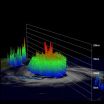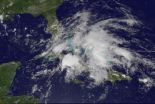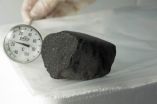(Press-News.org) Strong thunderstorms are the life's blood of tropical cyclones, and infrared and radar satellite data from NASA today confirms that the eastern Pacific Ocean's first hurricane has plenty of them and they're over 9 miles high. Adrian exploded in growth overnight from a tropical storm on June 8 to a major hurricane today.
NASA's Aqua satellite flew over Hurricane Adrian this morning at 8:29 UTC (1:59 a.m. EDT), and the Atmospheric Infrared Sounder instrument took an infrared snapshot of the storm's many strong thunderstorms and warm ocean water below.
The infrared data suggests that Adrian has an eye, as in the center of circulation on the infrared image is a blue-colored U-shape. Because AIRS imagery is false-colored, purple represents the highest, coldest cloud tops and strongest thunderstorms, and blue represents lower, warmer cloud tops. The coldest cloud top temperatures are as cold as or colder than -63 Fahrenheit (-52 Celsius). The blue area in the center of the larger area of purple in the imagery suggests that some overcast clouds are obscuring an eye. Other satellite data has confirmed the eye.
The Tropical Rainfall Measuring Mission (TRMM) satellite captured rainfall and cloud data from Hurricane Adrian when it passed directly above on June 9, 2011 at 0714 UTC (3:14 a.m. EDT). The increasingly powerful hurricane had sustained winds estimated to be close to 80 kts (~92 mph) at the time of this pass. TRMM's Precipitation Radar (PR) instrument revealed that beneath the clouds there were intense thunderstorms dropping rain at a rate of over 50 mm/hr (~2 inches) in a nearly circular eye wall. The PR also indicated that some thunderstorms in the eye wall were shooting up to heights above 15 km (~9.3 miles).
At 11 a.m. EDT (8 a.m. PDT), Hurricane Adrian had maximum sustained winds near 115 mph, making it a category three on the Saffir-Simpson scale and the season's first major hurricane as well as the first hurricane in the eastern Pacific. Hurricane force winds extend out from the center by up to 30 miles (45 km) and tropical storm force winds extend outward up to 80 miles (130 km).
Adrian was about 440 miles (710 km) south-southeast of Cabo Corrientes, Mexico near 14.2 North and 104.1 West. It was moving west-northwest near 9 mph (15 kmh) with a minimum central pressure of 960 millibars.
Hurricane Adrian's strength and proximity to land means that Southwestern Mexico's coastline will continue to get large swells and rip currents through the early part of the weekend. Adrian is expected to enter cooler waters by the early weekend which will sap some of his strength. The National Hurricane Center forecasts Adrian to continue moving out to sea and away from land.
INFORMATION:
NASA's infrared image of major Hurricane Adrian reveals its stormy life's blood
2011-06-10
ELSE PRESS RELEASES FROM THIS DATE:
Fragile X protein acts as toggle switch in brain cells
2011-06-10
New research shows how the protein missing in fragile X syndrome – the most common inherited form of intellectual disability – acts as a molecular toggle switch in brain cells.
The fragile X protein, called FMRP, hooks up with a group of molecules called microRNAs to switch the production of other proteins on and off in response to chemical signals, scientists at Emory University School of Medicine have discovered.
The results appear in the June 10 issue of Molecular Cell.
"For learning and memory to take place, neurons need to be able to make new proteins on demand, ...
Stretched-out low soaking the Caribbean in GOES-13 satellite imagery
2011-06-10
GOES-13 satellite imagery on June 9 shows that the pesky low pressure area in the north Caribbean Sea is stretching out and bringing soaking rains to Cuba, Hispaniola, Jamaica and Puerto Rico.
The Geostationary Operational Environmental Satellite called GOES-13 captured an image of this low on June 9 at 1740 UTC (1:40 p.m. EDT) System 94L, and the cloud cover appears centered over eastern Cuba and Jamaica while the outer portion of the low stretches over Hispaniola, Puerto Rico and now south Florida. The elongated low has a minimum central pressure of 1001 millibars and ...
Engaging high school students in soil science inquiry
2011-06-10
In April 2007, teacher Irka Elsevier and then-graduate student Biance Moebius-Clune began their second inquiry unit designed to enable high school students to better understand soil science concepts through their own research and experiments. Moebius-Clune was an NSF fellow in the Cornell Science Inquiry Partnerships (CSIP) program, which allowed the pair to develop inquiry curriculum to guide students through the process of doing research themselves.
Soil is fundamental to life and relevant to some of today's most pressing global issues, such as climate change and demand ...
NASA provides a 2-satellite view and video of the Chilean volcano eruption
2011-06-10
NASA's Aqua satellite and the GOES-13 satellite both captured their own unique views of the eruption of the Puyehue-Cordón Caulle volcano in Chile this week. One satellite provided a high-resolution image of the ash plume while the other provided a video showing the plumes movement over several days.
NASA's GOES Project released a satellite animation of the Puyehue-Cordón Caulle volcano that shows the movement of the ash plume over several days. The NASA GOES Project, located at NASA's Goddard Space Flight Center, Greenbelt, Md. created the animation from images obtained ...
Asteroid served up 'custom orders' of life's ingredients
2011-06-10
Some asteroids may have been like "molecular factories" cranking out life's ingredients and shipping them to Earth via meteorite impacts, according to scientists who've made discoveries of molecules essential for life in material from certain kinds of asteroids and comets. Now it appears that at least one may have been less like a rigid assembly line and more like a flexible diner that doesn't mind making changes to the menu.
In January, 2000, a large meteoroid exploded in the atmosphere over northern British Columbia, Canada, and rained fragments across the frozen surface ...
AgriLife research helps pave the way for a new livestock feed product
2011-06-10
AMARILLO – A two-year study by a Texas AgriLife Research team in Amarillo has helped bring a new product to market that could allow the cattle feeding industry to realize efficiencies in mills and more weight on cattle, according to Dr. Jim MacDonald.
MacDonald, an AgriLife Research beef cattle nutritionist, finished his second trial of cattle early this year studying starter diets in feedlots during the transition phase from pasture to feed yard.
Typically, a steer or heifer will come off of a forage diet when it goes into the feedlot, he explained. For the first ...
NASA's Dawn spacecraft approaches protoplanet Vesta
2011-06-10
NASA's Dawn mission to the doughnut-shaped asteroid belt between Mars and Jupiter, which launched in September 2007, is now approaching Vesta, a protoplanet that is currently some 143 million miles from Earth. Many surprises are likely awaiting the spacecraft.
"We often refer to Vesta as the smallest terrestrial planet," said Christopher T. Russell, a UCLA professor of geophysics and space physics and the mission's principal investigator. "It has planetary features and basically the same structure as Mercury, Venus, Earth and Mars. But because it is so small, it does ...
UCSB physicists apply Einstein's theory to superconducting circuits
2011-06-10
(Santa Barbara, Calif.) -- In recent years, UC Santa Barbara scientists showed that they could reproduce a basic superconductor using Einstein's general theory of relativity. Now, using the same theory, they have demonstrated that the Josephson junction could be reproduced. The results are explained in a recent issue of the journal Physical Review Letters.
The Josephson junction, a device that was first discovered by Brian David Josephson in the early 1960's, is a main ingredient in applications of superconductivity.
Gary Horowitz, professor of physics at UCSB, said ...
VELUX Introduces Low Profile Flat Glass Sun Tunnel Skylight
2011-06-10
VELUX America is introducing a low profile, flat glass design Sun Tunnel skylight at the International Builders' Show in Orlando.
The new model tubular skylight will captures more light while offering an enhanced roof profile and is ideal for use where acrylic dome Sun Tunnel skylights cannot be used. The new units will be available initially only in a 14" diameter model with rigid tubing.
Stephan Moyon, Director of Sales, says that Sun Tunnel skylights are perfect for any room where a view to the outside is not needed or where traditional skylights may not be ...
Analysis finds mortality from all causes higher among hepatitis C-infected
2011-06-10
[EMBARGOED FOR JUNE 10, 2011] Although liver-related mortality among those infected with hepatitis C is well-documented, little is known about deaths in these patients that are not related to liver problems. A new study published in Clinical Infectious Diseases and now available online (http://www.oxfordjournals.org/our_journals/cid/cir306.pdf) sought to determine mortality from all causes, including liver- and non-liver related deaths among hepatitis C patients in the general U.S. population. The analysis found mortality from all causes to be higher in these patients.
An ...




